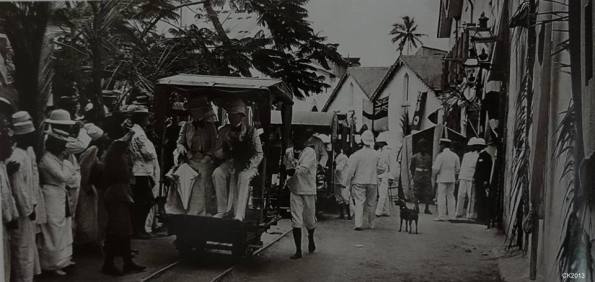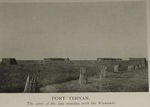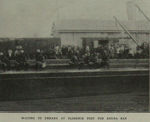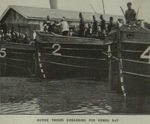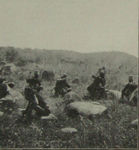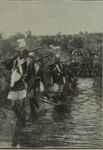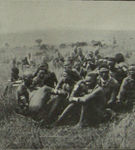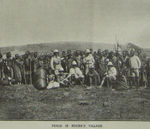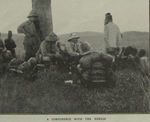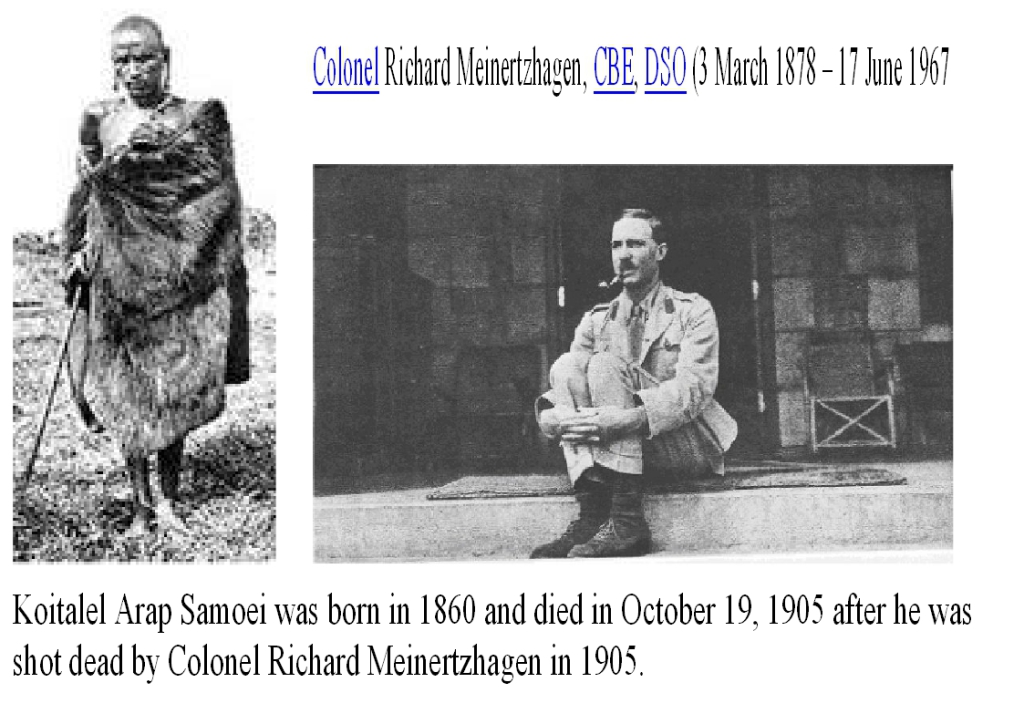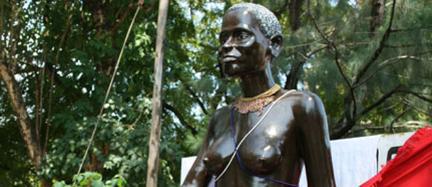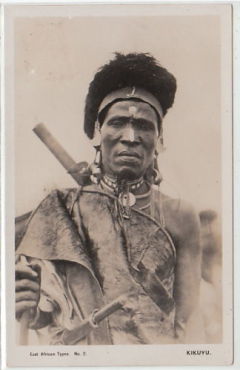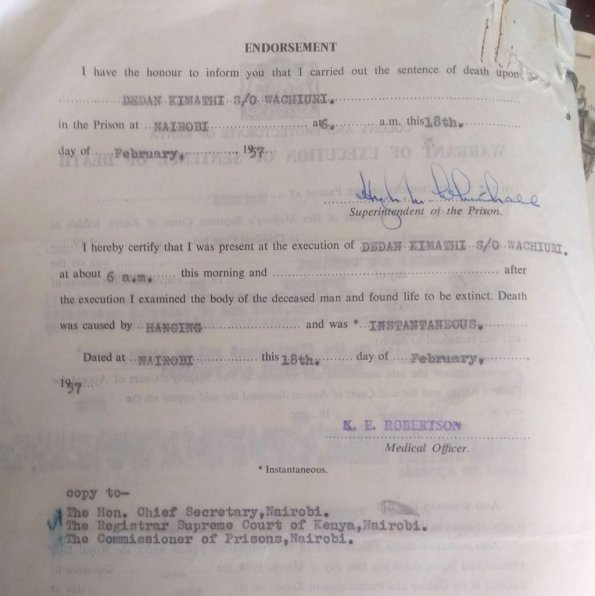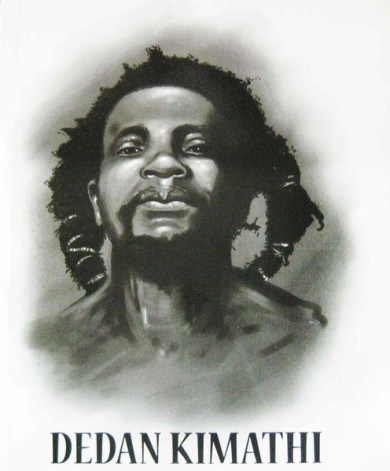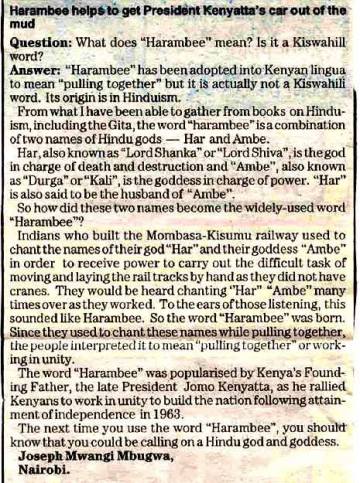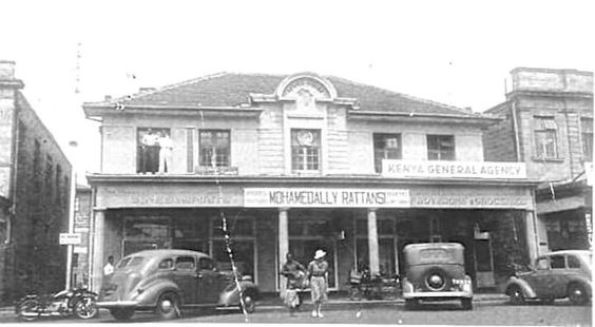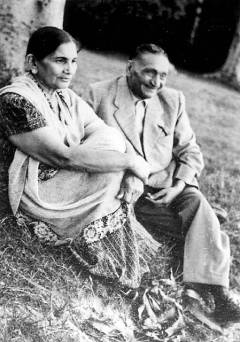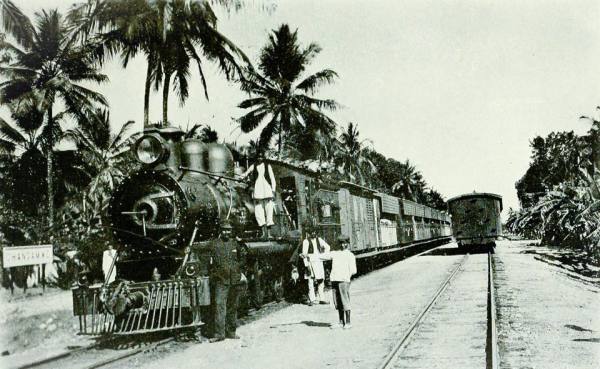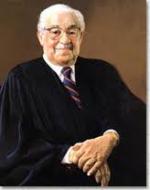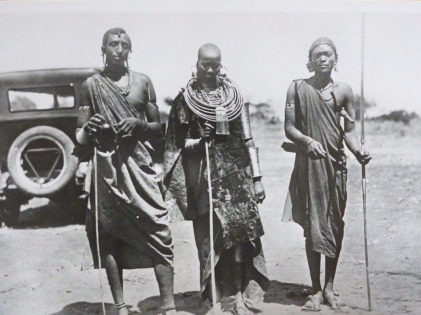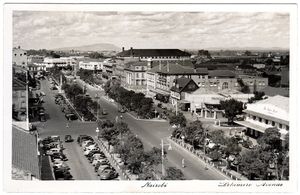Colonial Government of Kenya offered Zionists permanent settlement in Kenya
Mombasa Visit of Rt Hon Joseph Chamberlain ( he was briefly Britain's secretary for the colonies) and his wife in 1902, Mrs Chamberlain is seated next to Sir Charles
Eliot in the lead push car , they spent 6 days in the country on their way to South Africa.
During his visit , he gained the impression of a largely uninhibited land, ripe for exploitation, the seeds were sown for his subsequent decision to offer the Zionists 50000 square miles of East
Africa as a self-governing Jewish settlement under British protection. There was a public outcry however the offer was finally turned down by the Jews themselves for the sole reason that it would
have compromised their demands to carve out a Jewish homeland in Palestine. But for that Rejection, the future development of Kenya might have turned out differently ( Caroline Kere)
Fighting the Kisii
Reported 02nd May 1908
Last week brought details of the recent successful expedition against the Kisii clan in the British East Africa Protectorate inflamed by a “witch doctor” who prevailed as anti-European crusade rose in revolt, murdered several British subjects and attempted to assassinate Mr. Northcote, the British Resident. The operations took place that part of the Protectorate bordering the shores of the Lake Nyanza. The troops consisted of King’s African Rifles (KAR ) armed police and Nandi levies were sent to the scene of the Uganda Railways detrained at the Lake-Shore Terminus voyaged in Barges lighters to Kenda Bay (Kendu Bay) and thence had a two days’ march to the post at Kisii. The Column was more than a mile long of “drives” in disaffected country, the burning of huts and the capturing of cattle. There were a few casualties on either side. One of the chiefs, Ndube, who was dressed in European clothes Cawnpore helmet, received the force in peace at his village. The British Officers held numerous conferences with the native and the whole expedition was so successfully carried out, that though the scene of the trouble was 250 miles from the seat of the Government the operations were over in less than a month.
Colonel Richard Meinertzhagen, CBE, DSO (3 March 1878 – 17 June 1967)
By 1913 he was again in India.
From January 1915 through August 1916 Meinertzhagen served as chief of British military intelligence for the East Africa theatre at Nairobi. His diaries records of this campaign contain harsh
assessments of senior officers, of the role played by the Royal Navy and of the quality of the Indian units sent to East Africa.
His incompetency is what led to hundreds if not thousands British Indian troops killed in Tanga against the Germans.
Nandi Resistances (1894 – 1906)
https://www.african.cam.ac.uk/images/files/titles/nandi/view
Blessed with the gift of prophesy, this Kenyan King predicted slave trade and European invasion of his kingdom
----------------------------------------------------------------------------------------------------------------
East Africa 1700-1950
by Sanderson Beck
The Giriama and Colonial Resistance in Kenya, 18001920 (Uc Press Voices Revived) Paperback – 14 Aug. 2018
by Cynthia Brantley (Author)
The Giriama of Kenya's coastal hinterland persistently resisted colonialism, and they were unreceptive both to Christianity and to Islam. In 1912 the British colonial authorities earmarked the
Giriama as a key source of labor for the plantations Europeans were trying to develop along the coast. The Giriama, prosperous producers and traders, could not become wage laborers and maintain their
successful economy, and the British demands upon this scattered people therefore were spontaneously rejected. Increased pressure increased Giriama recalcitrance. Finally, military action brought
defeat to the Giriama, whose only weapons were bows and arrows and whose decentralization prevented coordinated resistance. They lost their best lands, paid a heavy fine, and had to contribute a
thousand laborers to the Carrier Corps. But the British costs were also heavy. The coastal plantations failed, few Giriama ever became wage laborers, and the entire area became depressed
economically.
https://www.amazon.co.uk/Giriama-Colonial-Resistance-Kenya-1800-1920/dp/0520302451
Mekatilili wa Menza—Freedom Fighter and Revolutionary
https://www.thisisthenest.com/comic-mekatilili
----------------------------------------------------------------------------
The (re)creation of a heroine: the case of Mekatilili wa Menza
------------------------------------------------------------------------------
Mekatilili wa Menza: Anti-Colonial Struggle in Kenya
https://capiremov.org/en/experience/mekatilili-wa-menza-anti-colonial-struggle-in-kenya/
--------------------------------------------------------
The ‘mad' Kenyan woman who rattled the British
Mekatilili wa Menza may have been in the freedom struggle scene for a short time, but her contribution in raising the African consciousness among the Giriama people of the Coastal Kenya was immense.
Mekatilili was one of the first women in Kenya to rise up against the British in 1913. Her bravery, oratorical power and charisma earned her a huge following and saw her mobilise the Giriama to take oaths and offer sacrifices to restore their sovereignty.
http://www.sourcememory.net/veleda/?p=28
-------------------------------------------------------------------------------
Mekatilili, prophetess of the 1913 Giriama revolt
By Veleda On January 17, 2011 Amazing: i found yet another medicine woman who led a revolt against colonial rule, Mekatilili of the Giriama in coastal Kenya. She “was noted as a
charismatic speaker who commanded respect.” She convoked the Giriama to take oaths and offer sacrifices to restore their sovereignty.
-----------------------------------------------------------------------------------
Mekatilili wa Menza: She Feared No Man
https://laplaceramz.wordpress.com/2009/11/10/mekatilili-wa-menza-she-feared-no-man/
-----------------------------------------------------------------------------------
Stunning new images celebrate Kenyan female icon who stood up to colonialists
------------------------------------------------------------------------------------
Although Champion did not openly confess that the government had lost all control over the Giriama, his recommendations for restrictions and force indicate how
completely the year of dedicated efforts on the part of the British government had failed. In his October report conceded that Mekatalili campaign had been effective “Every Giriyama is much afraid of
the Kiraho (oath) than of the government”.
At one point Champion frustrated pursued Mekatilili until finally, on 17 October , with the help of Mkowa and his deputy, he arrested her near Garashi. She signed a statement in Champions presence,
but did not admit to any wrong doing (Kombi wa Yeri statement). Later that same day Champion arrested Wanje (probably at his nearby home in Masendeni). Fisi….Literally, hyena; the most scared
Giriyama oath. Also, the medicine men who are qualified to administer the oath.
The increase in population occurred through continuous assimilation of people during the nineteenth century. Ex- slaves , Waata, Orama, and other Mijikenda joined the Giriama clans. Some entered Giriama families as dependents and others attached themselves to clans independently, but all were able to take advantage of Giriama trade.
---------------------------------------------------------------------------------------
Facts about the nine tribes of Mijikendas
The Mijikenda tribe is a Kenyan coastal Bantu tribe that consists of nine closely related sub-tribes.
The Mau Mau Uprising, a revolt against colonial rule in Kenya.
40,000 Kenyans accuse Britain of abuse and torture in second Mau Mau law suit.
This was certainly a sad episode in historic terms for many who got killed and lost their loved
one’s on both sides during the Mau Mau uprising but many have lost much more.
In Kenya the
bitter and violent Mau Mau rebellion against the British rule saw the death of thirty-two white settlers. But more than 1800 African civilians, over
3000 African police and soldiers, and 12,000 Mau Mau rebels were killed. In the war’s full seven-year course. Britain sent more 1000 of her African subjects to the gallows, and at the peak of the
struggle held more than 70,000 Africans in detention camps without trial Colonial Kenya was a Police state, as chillingly brutal as any other.
So it is only just that over 41,000
Kenyans have waged an attempt to sue the British government for compensation, alleging maltreatment and physical abuse during a Mau Mau uprising in the 1950s against UK colonial
rule.
The litigation suit, launched at the
high court in central London, marks the second Mau Mau case against the British Foreign and Commonwealth Office (FCO) in recent years. First one was successful as we all know: http://www.theguardian.com/.../britain-maumau-empire-waiting
http://rt.com/uk/200487-kenyans-sue-uk-government/
Dedan Kimathi
COURSE OF THE MAU-MAU MOVEMENT
Due to the failure of the Devonshire White paper to solve African problems, Africans started forming underground movements. Up to 1944 a European missionary represented Africans on the Legislative council. The Kenyan population broke down into secret societies on tribal and tradition basis.
After 1945, a number of political groups were formed some of which led to
the
formation of the Mau-Mau. The group that spearheaded this was that of the dissatisfied ex-soldiers known as the “FORTY GROUP” in 1946.They began by organizing opposition of
European policies e.g. stopping the kikuyu from terracing their land.
The group was then joined by the other groups and formed one called “Kenya Land and Freedom Army”. In 1946, they got in touch with Kenyatta after he had returned from Britain, he was the leader of the Kenya African Union (KAU) (after James Gichuru) and this organization was later called Mau-Mau.
http://www.elateafrica.org/elate/history/maumau/maumaumovement.html
Possible Etymology (Mau Mau) Wiki
The origin of the term Mau Mau is uncertain. According to some members of Mau Mau, they never referred to themselves as such, instead preferring the military title Kenya Land and Freedom Army
(KLFA).[20] Some publications, such as Fred Majdalany's State of Emergency: The Full Story of Mau Mau, claim it was an anagram of Uma Uma (which means "get out get out") and was a military codeword
based on a secret language-game Kikuyu boys used to play at the time of their circumcision. Majdalany also says the British simply used the name as a label for the Kikuyu ethnic community without
assigning any specific definition.[21]
Akamba people say the name Mau Mau came from ' Ma Umau' meaning 'Our Grandfathers'. The term was first used during a pastoralists revolt against de-stocking that took place in 1938 led by Muindi
Mbingu during which he urged the colonists to leave Kenya so that his people (the kamba) could live freely like the time of 'Our Grandfathers' (Twenda kwikala ta maau mau maitu, tuithye ngombe ta
Maau mau maitu, nundu nthi ino ni ya maau mau maitu).
As the movement progressed, a Swahili backronym was adopted: "Mzungu Aende Ulaya, Mwafrika Apate Uhuru" meaning "Let the foreigner go back abroad, let the African regain independence".[22] J.M.
Kariuki, a member of Mau Mau who was detained during the conflict, suggests the British preferred to use the term Mau Mau instead of KLFA to deny the Mau Mau rebellion international legitimacy.[23]
Kariuki also wrote that the term Mau Mau was adopted by the rebellion in order to counter what they regarded as colonial propaganda.[22]
https://www.facebook.com/maumaustory/posts/2778132555625046?__tn__=K-R
------------------------------------------------------------------------------------------------------------
Hassan, the mysterious Somali trader who funded Mau Mau fighters
-------------------------------------------------------------------------------------------------------------------
Mau Mau
In 1949, Richard Meinertzhagen, who was the scourge of the Kikuyus in the early 20th century and later converted to the African cause, made one of his visits to Kenya. He was then warned by one of the Kikuyu chiefs about a secret society that was shaping to throw the whites away from the country.
http://www.kenyalogy.com/eng/info/histo13.html
-------------------------------------------------------------------------------------------------------------
PSYOP of the Mau-Mau Uprising
http://www.psywar.org/maumau.php
-------------------------------------------------------------------------------------------------------------
Among the Kikuyu, the embrace of a radical political posture was symbolized by taking the oath of unity with and allegiance to the Mau Mau movement. This oath, initially administered at Kiambu in 1950, was supposed to “inject courage into those who were initiated” (Edgerton 1989). It was also supposed to be administered to as many Kikuyu as possible.
http://www.encyclopedia.com/topic/Mau_Mau.aspx
----------------------------------------------------------------------------------------------------------------
The spears and shield represent defense of Kenyan freedom.
https://sites.google.com/site/maumaurevolution/home
----------------------------------------------------------------------------------------------------------------
A massacre and a friendship – Kedong massacre (1895)
http://www.theeagora.com/the-massacre-that-bore-a-friendship-kedong-massacre-1895/
The 1895 Kedong Massacre: When The Maasai smote 600 Men In One Incident. Read on
The 1895 Kedong Massacre: When The Maasai smote 600 Men In One Incident. Read on
Pass holder, or kipande.
Under British colonial rule, papers inside this Kenyan kipande recorded its African owner’s name and work
history, and listed the rules restricting movement.
Gift of Ivan Karp
Lest We Forget…
Click on Photo to Enlarge
LEST WE FORGET...A GREAT MAN
Jaswant-Singh
Very little is known of his life after Kenya’s independence.
MR. JASWANT SINGH
Mr. Jaswant Singh Bharaj was born at Lakhpur in the Punjab in 1935 and while a child, first came to Kenya in 1940. His father had come to Kenya in 1914 and worked for the Uganda Railway. Jaswant
Singh left for India for education in 1947 and returned to Kenya in 1953.
Mr. Jaswant Singh had a special interest in the history of India, which led him to study the history of British domination in India since 1857. He also came across the history of Revolutionary Party of India, which believed in achieving freedom by violence. The incident of Jallianwala Bagh at Amritsar, and the inhuman atrocities of the British Forces against the common man made him resent the British in general.
Later, Mr. Jaswant Singh, on returning from India on 29th December 1953, was forced to join the Kenya Police Reserve. During his training he and his colleagues were badly and insultingly treated. Once he was struck on the crown of his head. This left a deep scar on his mind and turned him into an anti-British revolutionary.
This made him a sympathiser of the anti-White section among the Mau Mau and he commenced manufacturing and supplying them guns, ammunition and other material. He supplied piping to the Mau Mau Bush Fighters for making guns and taught to a few of them the art of gun-making.
He was arrested in May, 1954, tried and sentenced to be hanged In the appeal, the sentence was reduced to life imprisonment but he was released in 1958 after serving four and a half years in Takwa Detention Camp, off Mombasa, along with the other detainees such as Messrs. John Mbiyu Koinange, Mr. Achieng. Oneko and Mr. M.: C. Chokwe.
He was a sincere and selfless supporter of the African
struggle for freedom and served Africa and the African in every way possible. By profession he was a Carpenter, Mason, Plumber,
Electrician, builder, Radio and Motor Mechanic, Welder, Lorry Driver, Tractor Driver and Gun-maker. WHAT HAPPENED TO HIM, HIS FAMILY? Eager to know.
REMEMBER THIS PETITION? NOT MANY OF US KENYANS DO.
Seventeen (17) petition files containing signatures of 1,018,525 people, who prescribed to the plea for the release of Mr Jomo Kenyatta. They included 1,500 signatures of Asian women collected by Mrs Urmilaben Ramanbhai Patel (middle) and Mrs Saraswatiben Manubhai Patel (right), as well as 2,000 signatures of Europeans. GREAT WOMEN..
Kindly Provided and Narrated by Andrew Kuria
http://www.encyclopedia.com/topic/Jomo_Kenyatta.aspx
http://www.nationalarchives.gov.uk/documents/migrated-archives-4-guidance.pdf
Remembering the Late Bhagat Singh of Meru, Kenya by Jeff Itunga …
Field Marshall Musa Mwariama's wife, Jacinta Kabika Mwariama aka Gen. Nkobia. She achieved her desire to meet the family of the Meru Singh.
A hero, they say may not be recognised at their home, but that will never be the end of heroism. Today I take the honour of remembering the late Bhagat Singh, a great son of the great Meru Nation. This hero, without an iota of shame or indecision took upon himself, the duty of driving Field Marshall Musa Mwariama and Jacinta Mwariama, herself a designated military general, from their last hideouts of the dense Nyambene forest to Ruring'u Stadium, Nyeri to finally lay down their arms under the independent Kenyan flag. The journey wasn't without challenges and Bhagat against all the odds, of even being mistaken for a traitor or colonial sympathiser, braved it all for the love of freedom and the dignity of humanity. That successful journey and the achievements of the independence has been a great source of joy and pride for Bhagat, as long as he lived. The same will remain embedded in his family line forever. Yesterday's historic visit by Jacinta to the family of Bhagat Singh, was an ideal celebration of the role Bhagat played as a patriot in the attainment of the Kenyan freedom.
Click on Photo to enlarge
Asians Entrenched In Kenya’s Freedom Struggle
On 24th April 1954, a campaign by the British colonial government to purge Nairobi of Mau Mau fighters in Nairobi began. The campaign was known as Operation Anvil.
One of the first places to be raided was the Indian High Commission in Nairobi. Accusing the embassy of assisting Mau Mau and for providing “terrorists” with material support, British military officers roughed up staff members and bundled Africans working at the High Commission into trucks outside.
Of course, the Indian Government sent out a strongly worded protest letter to London, complaining about “diplomatic impunity” on the part of the British administration in Nairobi.
In his defence, sent to the War office in London, Kenya’s Governor, Evelyn Baring, explained that the action was justified as it was “backed by intelligence”.
And although the British government thereafter sent a meek apology, stating that “unfortunate words” were used during the operation, three further raids to the High Commission were authorized between June and November of 1954.
In the run up to the raid, it had become clear to the British that the support that Asians in Kenya were rendering the independence struggle was significant. Asians may not have entered the forests to actively fight alongside Mau Mau, but stories abound of cases in which members of their community provided material and moral support to the freedom struggle.
I start off with a tale of two Jaswant Singhs.
One was a Punjabi Sikh born in Lakhpur, Punjab, in 1935. He was the son of an engineer who had come to Kenya in 1914 to work on the railway. In 1947, Jaswant returned to India for his education but did not stay for long. He returned to Kenya in 1947 to serve in the Kenya Police Reserves as part of the mandatory Asian call-up.
During the emergency, he became sympathetic to the Mau Mau cause. For a period of at least five months, he not only manufactured arms and ammunition but also secretly taught freedom fighters in his area on how to use and service guns.
In May of 1954, Jaswant was arrested for his involvement in Mau Mau and detained, alongside other “most wanted” Indian prisoners, for a total of four and a half years at Takwa, in far away Lamu.
Then there was another Jaswant Singh who suffered a worse fate. Based in Molo, and typical of Kalasingas’ engineering mien, he was a carpenter, mason, plumber, electrician, tractor driver, builder, radio and motor mechanic, lorry driver, welder and gun maker all rolled into one.
Singh was arrested in September of 1954 for being in possession of two rounds of .32 ammunition that he intended to supply Mau Mau.
Prior to his arrest, a gîkûyû woman had offered to take him to a forest near Molo to meet with Mau Mau fighters. The Mau Mau fighters turned out to be the Kikuyu Home Guard, who arrested and handed him over to the colonial authorities. The Kalasinga was later sentenced to death.
Thakorbai Mangaldas Patel, a professional photographer, was another Asian who was incarcerated for his contribution to the freedom struggle. For weeks, he helped members of the Agîkûyû community forge their history-of-employment cards during the emergency.
When he was caught, aged only 25, he was put on a charge of “consorting with terrorist(s)”. He was however acquitted of that charge and instead jailed for five years with hard labour on the charge of document forgery.
In 1948, Dedan Kimathi was employed briefly at Keith Sawmills in Kiganjo, Nyeri. Its owner was Kundanlal Watson, who purchased two additional sawmills in Meru. At the height of the emergency, freedom fighters would send him appeals for food through his cook, who had taken “muuma” (oath). So Kundanlal would occasionally leave some food for the fighters at a cave near one of his sawmills. He also discreetly supplied piping for use in making guns.
Acting on a tip off, and having no concrete evidence with which to convict Kundanlal, the colonial police shut down one of his Meru sawmills.
When interviewed in the 1980s, Kundanlal said he became sympathetic to the freedom struggle when he saw truckloads of Mau Mau, some of whom were dead and others alive, emerging from the forests. The Mau Mau freedom struggle also reminded him of the agitation that had led to India gaining independence, he added.
Yet another Asian who owned a sawmill near Karatina was Qayyum Dar. He had left Lahore (Pakistan) in 1947 to join his cousin in Kenya, and later immersed himself in the timber business. In October of 1952, which is the very month the colonial government declared a state of emergency in Kenya, a freedom fighter called Mukunga reportedly called on his premises to administer muuma to sawmill employees.
Dar agreed to take the oath, pledging his loyalty to Mau Mau. The oathing ritual required him to take a bite of meat and also drink blood. And as he revealed later in 2006, whilst he took a bite of the meat, he politely declined to drink blood, explaining to Mukunga that his religion (Islam) barred him from doing so.
From then on, freedom fighters would secretly collect food, clothing, medicine and newspapers, from a spot near his house at night. But one day, a faction of Mau Mau fighters confronted him and threatened to kill him “as his skin is different”.
It took the intervention of his oathed workers and Warûhiu Itote (General China) to save him. The Mau Mau fighters were told that Dar was “one of us”. They spared him but took his gun.
As he was a licensed gun owner, Dar was forced to report the “theft”. The police authorities did not quite believe him and put him under surveillance. They weren’t quite convinced that the Mau Mau fighters spared him without inflicting any physical harm.
Weeks later, an Italian mechanic who lived near Dar’s house reported him to the police. The Italian had stumbled on the hideout within the sawmiller’s residence from which Mau Mau fighters collected supplies at night. Dar was out in his sawmill when the police came over to investigate the hideout.
So when he returned home that night, his gîkûyû maid sent him out to town in the pretext that food supplies had ran out. Some Mau Mau fighters had told her that they would return in the night to kill the mechanic. She feared the attack would happen while her boss was at home.
It wasn’t long before Dar was arrested, however. He gave himself away when he climbed a tree at his house and whistled to fighters in the forest to come over and collect supplies. Armed European police officers lurking nearby immediately placed him under arrest.
Besides banning him from ever setting foot in GEMA country, police threatened to deport him either to Manyani, where his sawmill workers were sent, or to Pakistan, his native country.
He pleaded with them to send him to Kakamega, where he ran another sawmill. To this request, the police agreed but made it mandatory for him to be reporting to the nearest police station on a weekly basis (sounds familiar?). This Dar did until the end of the emergency.
In those days (of emergency), members of the Agîkûyû community were not allowed to shuttle between the farm regions and towns. That is partly why they had the kipande; to not only help identify them but also restrict their movements.
Karatina trader, Hassanali Manji, who was also fluent in the gîkûyû language, would deliver salaries of town workers to their families in the rural areas. He also secretly supplied food to forest fighters.
Then there is another interesting story among others cited in the book, “Indians In Kenya: The Politics Of Diaspora, by Sana Aiyar. It is the story of an Asian lady, Malvi Keharchand Kent, who would refuse police on patrol and search duties to enter her house on the plea that it was prayer time. As her farm workers hid under the bed, she would sit on it, holding her prayer beads in mock prayer.
As the freedom struggle in Kenya raged, authorities in London commissioned a special probe on the Mau Mau. The probe was led by F.D. Corfield, a former Governor of Khartoum.
The Corfield Report cited testimonies from captured Mau Mau fighters, who reportedly confessed that some of their illicit guns came from India. Following this report, the colonial government made tactical changes in their fight against Mau Mau. A number of Asians were deported on suspicion that they provided support to freedom fighters.
Yet, in spite of the deportations, more Asians continued to support the freedom struggle. J.M. Desai, whose house hosted many meetings of KAU leaders, supported independent schools in Kiambu and was among Asians who stealthily offered support to the independence struggle. He carried out research on these independent schools and started a photographic collection of them. According to author Sana, the colonial government viewed Desai as a “communist agitator”.
Then there is the Patel family of Ambu and Lila Patel, who housed Margaret Kenyatta while her dad was in detention it Maralal.
There are far more Asians who played a prominent role in the freedom struggle in various ways. If it wasn’t in the rural townships near the forests, it was on other platforms such as the colonial regime’s courts,, where they defended leading lights in the independence struggle.
Maybe in future I will write about other Kenyans of Asian extraction not cited herein. But when our story of the independence struggle is written, the role that Asians played cannot be overlooked. Indeed, they quickly assimilated themselves onto various spheres of Kenya’s economic and socio-cultural development after independence.
Among Kenyans irrespective of race that I consider to be among the most steadfast in their patriotism is fiery trade union leader Makhan Singh (pictured).
Go on, read his story via the link below (some photos used for illustration purposes).
<< New text box >>
Kenya: Harambee is not a Hindu god and can not be a hindu word it is a Swahili word and Kenyan 12 Replies Dear Friends, I would like to say that as much as the word Harambee may sound the same as the Hindu word Hare Ambe or the like I object in the strongest terms that it means the same with what …
It is in History that Mzee Jomo Kenyatta is the one who used this word “ Harambee” when he found the Mijikenda people
using it to urge the people to work together. The word is a Bantu word from one of the Miji Kenda dialect Halumbe which means pull or push together.
So, why use this word “Harambee” when Kenyatta was himself from a Kikuyu back ground?
One has to read African history and the name Mekatilili, prophetess of the 1913 Giriama revolt is held high amongst many Kenyans.
Among the nine Mijikenda sub-tribes, the Giriama and the Digo are the most well-known, most populous, and therefore, most dominant along the Kenyan coast. The other seven sub-tribes are the Chonyi,
Duruma, Jibana, Kambe, Kauma, Rabai and Ribe. It's very common for other Kenyan tribes to refer to all Mijikenda people simply as Giriama.
Mekatilili wa Menza was born in the 1840s, the only daughter in a poor family of five children “She is a heroine of her and our time also. She advocated freedom and basic human rights for all,” an
amazing super human being of that time and taking on the might of the British was unheard of….
Killing of Isher Dass
The bodies of two Sikhs who were hanged at Kamiti Maximum prison in 1942 for murdering Isher Dass ,a Kenyan Politician and a champion of the rights of Africans .His murder was the first political assassination of a sitting member of LegCo (now parliament) in the history of Kenya .Dass who was a great Orator and Marxist arrived in Kenya in 1927 after he was hired by Jeevanjee to sell radios .
He later ventured into politics and quickly became a thorn in the side of the colonial government. In LegCo he established himself as the de facto spokesman of Africans and Indians grievances .In 1938 when Muindi Mbingu led Akamba in protest over cattle destocking measures introduced in Ukambani by the colonial government, it was Dass who pressed their case viciously to the government .He helped Muindi Mbingu write a letter of protest to the Governor which he himself (Dass) delivered to the Governor.
Mbingu was later arrested and detained for leading the protest , something that made Dass to even stirr more trouble. On August 17th after failing severally to overturn the detention of Mbingu, he made a long and impassioned speech in defence of the Akamba in LegCo. The same year he travelled to Nyanza (Kavirondo) together with Jesse Kariuki where he warned Luos and Luhyas against giving their land to Europeans ,he also warned the government that it could not ignore the voices of Africans for too long without difficulty.
Although to Africans he was a militant Indian who supported African courses back in India at the start of World War 1 he was already being seen as a traitor. He had taken the position of director of Indian man Power during the war, a position which he used to forcefully recruit Indians to fight for the British.
His sudden decision to support the British earned him more enemies and on 6th November 1942 he was shot in his office inside Desai Memorial hall Nairobi by two Sikhs.
The two sikhs were treated as martyrs by Indians .
Odhiambo Levin Opiyo
Mohamedally and Maniben Rattansi Educational Trust
Mohamedally Rattansi was a humble man who never sought publicity for himself, not even when he founded a large Educational Trust. Only at the insistence of the founding Directors appointed to run the Trust was he persuaded that a formal ceremony be held for him to consign the property deeds to the then Governor of Kenya, Sir Evelyn Baring.
https://ismailimail.blog/2009/12/17/fulfilling-a-dream-rattansi-educational-trust/
https://www.geni.com/people/Maniben-Rattansi/6000000002106274284
Kenya's Wahindis
The uneasy life of Indians in Kenya.
http://www.littleindia.com/nri/4417-kenya-039-s-wahindis.html
Taxation without Principles:
A Historical analysis of the Kenyan Taxation System
Attiya Waris*
Attiya Waris is an Assistant Lecturer, Department of Commercial Law,
School of Law of the University of Nairobi in Kenya.
http://gw.geneanet.org/ajbg?lang=en;p=marie+madeleine;n=larrieu+let;type=tree
US Lawyer who Wrote Kenya's First Constitution
The lawyer who wrote Kenya’s first laws was a stickler for justice and was so incensed by the founding President Jomo Kenyatta for ‘discriminating’ against Asians after he was made Prime Minister in 1963.
The lawyer who wrote Kenya’s first laws was a stickler for justice and was so incensed by the founding President Jomo Kenyatta for ‘discriminating’ against Asians after he was made Prime Minister in 1963. US civil rights lawyer Thurgood Marshall had warmed his way into the hearts of locals who were spearheading Kenya’s fight against the colonialists, by offering invaluable constitutional insights. He also served as Kenyatta’s legal advisor at the Lancaster Kenyan constitutional making process.
Read more at: https://www.standardmedia.co.ke/article/2000091468/us-lawyer-who-wrote-kenya-s-first-constitution
A glimpse of the people, incidents, facts and figures that tell the Kenyan story


